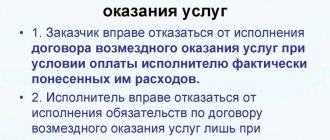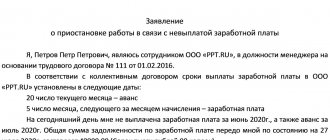Returning money is not as easy as lending it. If the debtor does not want to repay the borrowed funds, the issue will have to be resolved in court. Therefore, you need to properly prepare a claim for debt collection.
The instructions will tell you how to file a claim for collection and return money. Will warn against mistakes when drawing up a claim, which lead to denial of claims.
Algorithm for drawing up an application
The statement consists of three parts: introductory, descriptive and conclusive. It is important to fill out the application correctly and indicate the facts relevant to the case.
4 components of a claim
- The introductory part indicates the name of the judicial authority and the names of the parties. If your interests are represented by a lawyer, then you need to provide information about the representative. The information is needed so that court specialists can contact you or a representative. General rule: the application must be sent to the place where the defendant is located, if it is a legal entity. According to the rules of the Civil Procedure Code, you must apply at the debtor’s place of residence. But there are exceptions to the rule. You can contact the justice authority at your place of residence if you become a party to a dispute under the Law “On the Protection of Consumer Rights”.
- The descriptive part contains an indication of the relationship of the parties. It is necessary to indicate that the transfer of money as a loan is confirmed by a receipt or provide other evidence of the transfer of funds. Then you need to explain what exactly the essence of the violations is. Indicate how many days there was a delay in fulfilling the obligation. Calculate the amount of penalties.
- Let's conclude. In the final part, the plaintiff’s claims are indicated and references are made to articles of the Civil Code.
- Application. The documents attached to the application are listed here.
To fill out the claim, we suggest using the attached sample.
Contents of the document
A written statement by the initiator, called the plaintiff, in which he/she must state their case: the facts on which they intend to rely, to the defendant and for the purpose of carrying out a civil process and judicial determination.
A statement of claim for the recovery of funds and penalties under a work contract is a document of a procedural nature and the established form, containing the applicant’s appeal to the court with a request to consider and resolve a specific dispute in accordance with the limitation period of Art. 196 of the Civil Code of the Russian Federation.
A document that must be correctly drawn up and submitted to the court, in which the plaintiff must set out supporting facts (contract, acceptance certificate, estimate, etc.), must be drawn up in the appropriate form and disclose the full essence of the rights violated. The level of detail is a matter of debate among lawyers: more experienced ones prefer brevity, others prefer to fully disclose the facts so that they are transparent and so as not to risk having the court later throw out any allegations they want to make at trial on the grounds that they were not stated in the claim and claim.
Is it necessary to submit a claim?
For entrepreneurs, the procedure is established by the Arbitration Procedure Code. If the claim has not been submitted, the judge will not accept the claim. Therefore, send a claim to the debtor, wait thirty days, unless a different period is specified in the agreement. Then you can contact the justice authorities.
It would be a big mistake to go to court without a claim. The judge will simply reject the claim because the requirements of the APC are violated.
Individuals are not required to submit claims.
But we do not recommend neglecting the pre-trial procedure for resolving the conflict. Sometimes, a claim is enough to repay the debt. In your complaint, indicate that the loan repayment deadline has been missed, and you intend to contact the judicial authority in the near future. Perhaps the debtor does not object to payment, but cannot pay the entire amount at once. In this case, we recommend drawing up a written agreement on restructuring and specifying the procedure for making payments in the document.
Debt collection under a service agreement in arbitration court
If services are not provided, then the customer has the right to recover an “unearned advance.” Or, conversely, the services are provided and accepted by the customer, but the customer refuses to pay; in this case, the contractor also has the right to recover the debt for the services provided in court. Disputes regarding debt collection under a service agreement between legal entities (individual entrepreneurs) will be discussed in this article. Cases on economic disputes and other cases related to the implementation of entrepreneurial and other economic activities are subject to the jurisdiction of the arbitration court. Therefore, if a contract for the provision of services was concluded while the parties were carrying out business activities, then this dispute is subject to the jurisdiction of the arbitration court. In other cases (when concluding a contract for the provision of services between individuals or between a legal entity (IP) and an individual, as well as if the activities of the IP are terminated), such disputes are considered in a court of general jurisdiction. Also, if you are interested in debt collection under a work contract (work performance), in particular under a construction contract, we recommend that you read the separate article “Debt collection under a work contract”, since the work contract has its own nuances that determine the features of debt collection.
Step-by-step instructions “Collection of debt under a service agreement in an arbitration court”
To collect debt under a service agreement, as well as penalties for late payment or interest under Art. 395 of the Civil Code of the Russian Federation, interest under Art. 317.1 of the Civil Code of the Russian Federation, we recommend adhering to the following algorithm.
Step 1. Clarification of information about the existence of bankruptcy proceedings against the debtor
From the date the arbitration court issues a ruling recognizing as justified an application to declare a citizen bankrupt and introduce the restructuring of his debts (for individuals), supervision (for legal entities), the following consequences occur, in particular:
- the deadline for fulfilling monetary obligations that arose before the court accepted the application is considered to have occurred
- the accrual of penalties (fines, fines), other financial sanctions and interest on a citizen’s obligations, except for current payments, ceases
The procedure for the creditor's actions and the time frame for protecting its property interests in the event of bankruptcy of the debtor depends on the legal nature of the claims against the debtor, as well as on the procedure introduced in relation to the debtor. You can familiarize yourself with the procedure for the bankruptcy of a debtor in the article “Bankruptcy of a debtor: what should a creditor do?” This article will further discuss the actions of the creditor when collecting a debt if the debtor is not bankrupt.
Step 2. Preparation and submission of a claim demanding payment of debt under a service agreement, other amounts (penalties, interest under Article 395 of the Civil Code of the Russian Federation)
It is important to correctly draw up and submit a claim for payment of debt under a service agreement and other amounts. Having received a claim, the debtor can voluntarily satisfy your demands, which will avoid going to court. If he does not do this, you will have evidence of compliance with the claim procedure (for disputes within the jurisdiction of the arbitration court, compliance with this procedure is mandatory).
We recommend that you detail all your future claims in your complaint. Also indicate in the claim the amount of interest/penalty; to do this, determine the period for accrual of interest (penalty) and provide their calculation. Attach documents confirming your calculation to your claim, if necessary. If the claim is signed not by the manager (the person listed in the Unified State Register of Legal Entities), but by a representative under a power of attorney, attach a copy of the power of attorney, which contains the authority to sign such documents.
Send the claim to a legal entity (individual entrepreneur) at the so-called “legal address” - the address contained in the Unified State Register of Legal Entities (USRIP), and to the address indicated by the debtor, for example, in the contract as a postal address. In order to clarify the current “legal” address, use the free service “Check yourself and your counterparty” on the website of the Federal Tax Service of Russia. After widespread mass checks by tax inspectors on the accuracy of the addresses of legal entities, many addresses indicated in the Unified State Register of Legal Entities began to coincide with actual addresses.
We recommend sending the claim to the debtor by registered mail with a list of the contents and keeping the postal receipt and list of the contents, since these documents must be attached to the claim. When delivering a claim against signature, you must ensure the authority of the person accepting the claim; when the claim is received by a representative, obtain a copy of the representative’s power of attorney. You can additionally send a claim by email or serve it in another way in order to resolve the issue amicably. That is, you must have documents confirming that the claim procedure has been properly followed, if you still have to go to court, but you have the right to notify the debtor about the debt by any other means, and negotiate to collect the debt under the service agreement in a pre-trial manner.
What is the deadline for responding to a claim for payment of debt under a service agreement?
The general claim period is 30 calendar days from the date of sending the claim to the debtor, unless a different period is established in the service agreement (for example, the parties can provide 10 days from the date of sending the claim, or vice versa, increase the claim period; you can also change the point in the contract, from which the claim period is calculated). Therefore, before going to court, carefully study your supply contract for any claim deadlines.
Step 3. Preparation and submission of a statement of claim demanding the collection of debt under a service agreement to the court
Requests for collection of debt under a contract for the provision of services, interest (penalties) for late payment for services rendered or the return of an advance for services not provided are subject to a general three-year statute of limitations established in paragraph 1 of Art. 196 of the Civil Code of the Russian Federation. The limitation period under a service agreement is calculated separately for each late payment. Payment is determined for each day of delay. For example, a framework agreement for the provision of services has been concluded for a period of one year, to this agreement for the provision of services the parties sign additional agreements (appendices) for the provision of individual services under the agreement, each attachment sets its own payment period. The limitation period in this case will be calculated for each debt separately.
Example: In accordance with the appendix to the service agreement No. 1, payment for the services provided for in the appendix must be made within 10 days from the date of signing the certificate of services rendered. The act was signed on 03/11/2019, that is, the service must be paid until 03/21/2019 (inclusive). The delay began on March 22, 2019. The statute of limitations for filing a claim in court for debt collection under Appendix No. 1 to the service agreement expires on March 22, 2022. It does not matter that the validity period of the framework agreement for the provision of services is until December 31, 2019.
Thus, for each late payment under a service agreement, the deadline for its payment in accordance with the agreement is calculated, based on this period, the statute of limitations for collecting this debt is taken into account.
When returning an advance, it is necessary to proceed from the deadline for repaying the advance established by the contract or the general provisions of the Civil Code of the Russian Federation (in some cases it may be tied to the expiration date of the contract). The limitation period must be calculated from the date of expiration of this period.
Some creditors mistakenly believe that the statute of limitations begins to run from the expiration date of the contract, and therefore delay collecting debt until the end of the service agreement; under long-term service agreements, this can lead to the expiration of the statute of limitations for a number of debts for services rendered (The stated position on calculating the limitation period is contained in the Resolution of the Plenum of the Supreme Court of the Russian Federation dated September 29, 2015 No. 43).
Also, when calculating the limitation period for collecting penalties (interest) for late payment for services, it is necessary to proceed from the fact that the period is calculated separately for each day of delay.
An example of calculating the limitation period when collecting a penalty for late payment under a service agreement: The payment period for the service is November 6, 2017. The penalty for payment, which must be made before 06.11.2017, begins to run from 07.11.2017, the limitation period for the penalty is calculated for each day of delay, that is, for the day of delay on 07.11.2017 it expires on 07.11.2020, 08.11.2017 - 08.11.2020, etc.
A statement of claim can be filed in court even after the expiration of the statute of limitations, but if the defendant in court declares that the statute of limitations has expired, the court will refuse to collect the debt, interest (penalty), for which the statute of limitations for going to court has expired. It is also important to take into account that, within the meaning of paragraph 3 of Article 202 of the Civil Code of the Russian Federation, compliance by the parties with the claim procedure provided for by law is not counted towards the limitation period, in fact extending it for this period of time. At the same time, the defendant may, for some reason, fail to declare the statute of limitations expired (for example, if he does not receive notice of the consideration of the case in court, does not appear in court and does not send written objections, out of ignorance, etc.), in In this case, the court will satisfy the claim. Therefore, when going to court, it is necessary to assess the risks: how high is the likelihood of filing objections, what is the difference in the amount of the state fee paid for consideration of the claim in court, if claims are filed with an expired statute of limitations (if the claims are refused due to the expiration of the statute of limitations, the state fee will not be returned).
Jurisdiction in cases of debt collection under a service agreement
As a general rule, claims for debt collection are filed with the court at the place of registration of the defendant, unless other jurisdiction is established by the agreement. If an agreement is concluded with a branch or representative office of a legal entity, then the claim can be filed in court both at the location of the branch (representative office) and at the location of the defendant (Parts 5, 7, Article 36 of the Arbitration Procedure Code of the Russian Federation). Please keep in mind that information about the branch or representative office must be indicated in the Unified State Register of Legal Entities (clause 3 of Article 55 of the Civil Code of the Russian Federation). In addition, Art. 36 of the Arbitration Procedure Code of the Russian Federation gives the right to the plaintiff in a claim arising from an agreement in which the place of its execution is indicated, to also present it to the arbitration court at the place of execution of the agreement (at the choice of the plaintiff).
All the above rules apply unless the service agreement specifies other jurisdiction. Legal entities and individual entrepreneurs are free to choose the contractual jurisdiction. Please note that the agreement may also provide that all disputes are referred to an arbitration court (arbitration), in this case, in order to collect the debt under the agreement, you must contact this court (with some exceptions) and pay a fee at the rates of this court , proceed from the rules of procedure of this arbitration court.
A statement of claim may be filed with the arbitration court:
- through an electronic system for filing documents with the court
- personally or through a representative on the expedition of the ship
- sent by Russian Post or other postal/courier service
How to draw up a statement of claim for debt collection under a service agreement?
It is important that the claim for debt collection under a service contract be drawn up in compliance with the requirements of Art. 125 of the Arbitration Procedure Code of the Russian Federation, namely:
- make a claim in writing
- indicate in it the name of the court to which the claim is being sent; data of the plaintiff, defendant, third parties
- describe the requirements in the claim with references to the provisions of the law, contract and other regulations
- indicate the price of the claim (it includes the total amount of the debt that you are asking to collect, as well as accrued penalties, interest; state fees and other legal expenses do not need to be included in the cost of the claim; attach to the claim a calculation of the claims, indicate the amount of the state duty; we recommend that you submit a calculation of the amount to be recovered amounts as an appendix to the claim and indicate in the claim itself that the calculation is given in the appendix)
- indicate in the claim the date the claim was sent to the defendant, the claim period
- You can also file a petition for the imposition of interim measures (seizure of funds in an account, etc.) - measures aimed at ensuring the execution of a court decision to collect money; you can immediately formulate other petitions in the claim, including a petition to obtain evidence from the defendant or other persons
- indicate in the statement of claim a list of attached documents
If the above requirements are not met, the arbitration court will leave the claim without progress. This will mean suspending the process of accepting the claim for consideration in order to eliminate shortcomings in the preparation and filing of the claim. After the plaintiff eliminates these shortcomings, the court will accept the claim, otherwise the court will return the claim. Errors in the claim, incompleteness of the attached documents can significantly increase the period of debt collection, which is very important in the process of actual execution of the court decision on collection (the financial condition of the defendant can change very quickly).
The heading of the claim indicates the name of the court, details of the plaintiff, defendant, third parties, the price of the claim and the amount of the state duty.
It should be noted that in accordance with Art. 64 of the Arbitration Procedure Code of the Russian Federation, each person participating in the case must prove the circumstances to which he refers as the basis for his claims and objections. In this regard, it is important that all arguments stated in the statement of claim are based on evidence.
Statement of claim for collection of debt for services rendered
Indicate in the claim for collection of debt for payment for services under the contract the following circumstances and evidence that confirms them:
- conclusion of a contract for the provision of services (write its name, number, date of conclusion, and also indicate the terms of the contract with links to the number of the clause of the contract: name of the service, price of the service, payment term (if necessary, provide links to additional agreements, annexes to the contract, if the contract is a framework contract or its terms have changed; if the payment period is not agreed upon, justify the payment period you are calculating based on the law and judicial practice); about the amount of the penalty, if it is provided for in the contract)
- provision of services (indicate the details of the certificate of services rendered, other document that confirms the fact and date of acceptance by the customer of the services provided)
- non-payment (late payment) by the customer for services (indicate the periods of delay; if you are attaching multi-page accounting documents as confirmation, we recommend indicating which page contains the necessary information and what to pay attention to)
- calculation of debt and penalties
- fact of filing a claim and compliance with the claim deadline
Statement of claim for recovery of advance payment (prepayment) for services not provided
In your claim for recovery of an advance payment under a service agreement for services not provided, indicate the following circumstances and evidence that confirm them:
- conclusion of a contract for the provision of services (write its name, number, date of conclusion, and also indicate the terms of the contract with links to the number of the clause of the contract: name of services, price of services, term of provision of services (if necessary, provide links to appendices, additional agreements to the contract, if the contract framework or its terms have changed; if the term for the provision of services is not agreed upon, justify the period you are calculating based on the law and judicial practice); o the amount of the penalty for late repayment of the advance, if it is provided for in the contract)
- payment for the cost of services (indicate details: number and date of payment documents that confirm the fact and date of payment for services)
- failure to provide services by the contractor
- calculation of debt and penalties
- fact of filing a claim and compliance with the claim deadline
Is it possible to collect debt under a service agreement in the absence of certificates of services rendered?
Collection of debt for payment for services in the absence of a signed acceptance certificate for services rendered is possible subject to proof of the actual provision of services. At the same time, it is more difficult to prove the provision of services without a certificate of services rendered than the fact that work was performed, since there is no material result.
Example from practice: The court recognized the customer’s directions for performing tire fitting work at the contractor’s service station, issued by the customer, entries in the notebook for recording the performed tire fitting work, which indicated the date of receipt of the defendant’s cars at the plaintiff’s service station, their state number, the driver’s last name, his signature, the type of work performed works and their cost, adequate proof of the fact of work completion in the absence of an act. Resolution of the Federal Antimonopoly Service of the Volga District dated June 28, 2012 in case No. A49-5634/2011.
The provision of services may be confirmed by a power of attorney issued by the customer, explanations, documents from third parties confirming the provision of services (for example, when representing interests in court, the provision of services may be confirmed by the minutes of the court session), correspondence, witness testimony, testimony of communication equipment, and other technical means. At the same time, one-sided documents, for example, an invoice, are not recognized as evidence of the provision of services. Also, partial payment under the contract for the provision of services (if the contract stipulates that payment is made after the provision of services) may be one of the proofs of the provision of services.
However, it should be taken into account that judicial practice on the issue of the need for the parties to draw up an act on the provision of services is ambiguous. Thus, some courts recognize that if there is other evidence of the provision of services, the absence of an act does not exempt the customer from paying for them even if its preparation is provided for in the contract. Other courts, on the contrary, indicate that the act must be drawn up after the provision of services and is necessary evidence of the fact of their provision. There is also a position according to which the signing of an act is necessary in the case where the parties drew up such acts for a long time before the dispute arose. The court may also apply paragraph 4 of Art. 753 of the Civil Code of the Russian Federation and collect payment for services provided in the presence of an act signed by the contractor unilaterally, if the customer unmotivatedly refused to sign it. At the same time, there is an opposite position of the courts, according to which the provisions of Art. 753 of the Civil Code of the Russian Federation do not apply.
We recommend that you read the article on debt collection without documents.
In the petition part, clearly formulate your claims. You need to list the requirements for the counterparty with references to the standards. We recommend that in your introductory sentence you list all the norms of the Civil Code of the Russian Federation - the grounds for satisfying your demands, as well as the norms of the Arbitration Procedural Code of the Russian Federation, which you followed when preparing and filing a claim. After it, list the claims against the defendant. It can be:
- amount of debt under the service agreement
- the amount of penalties (penalties) and/or interest under Art. 395 Civil Code of the Russian Federation
- legal expenses (state fees, representative expenses)
Legal advice: When applying to court, we recommend that you declare all possible penalties for collection from the debtor, including for previous delays in payment for services on the part of the defendant, while taking into account the statute of limitations (for example, the defendant orders services for 3 years, during the term of the contract the defendant often delayed payment for services, did not pay for the last services provided for a long time, so the plaintiff decides to go to court to collect the debt, while the plaintiff has the right to file a penalty for late payment (interest) not only on overdue receivables, but also on all previous overdue).
Find out how to correctly calculate the penalty and interest for the use of funds when collecting a debt here.
Before filing a claim for collection of debt under a service agreement, it is necessary to send the claim and documents to it to the defendant, third parties (send the claim in a valuable letter with an inventory of the attachments, list all the documents sent in the inventory).
Documents for debt collection under a service agreement in court
When filing a claim for debt collection under a service agreement, the following documents must be attached to the arbitration court:
- copy of the service agreement
- copies of acts of services rendered, other evidence of the provision of services in the absence of acts (if a debt is being collected for services rendered) or copies of payment documents (if an “unprocessed” advance is being collected)
- act of reconciliation of mutual settlements
- calculation of claims for debt collection, penalties, interest from the defendant
- copies of documents confirming compliance with the claim deadline (inventory of the attachment, postal receipt, notification of receipt or printout of information from the Russian Post website)
- a copy of the certificate of registration of the plaintiff as a legal entity
- a copy of the decision to appoint a person acting without a power of attorney on behalf of the legal entity - the plaintiff
- extracts from the Unified State Register of Legal Entities (USRIP) regarding the plaintiff and defendant
- a copy of the power of attorney, if the claim is signed by a representative
- documents confirming the sending of the claim and documents to it to the defendant, third parties (postal receipt of dispatch, list of attachments)
- copies of documents confirming payment of legal costs (if any - for example, when engaging a lawyer to collect a debt)
- document confirming payment of the state fee for consideration of the claim in court
State fee for consideration of a claim for debt collection under a service agreement in court
The process of debt collection in court is not free; to file a claim, you must pay a state fee or submit a request for an installment plan/deferment of payment of the state fee in the prescribed manner (in some cases, plaintiffs are exempt from paying the state fee, in this case it is necessary to indicate the basis for the exemption from paying the fee). Otherwise, the arbitration court will issue a ruling to leave the claim without progress, in which it will propose to eliminate the violations committed.
The amount of the state duty is established by the Tax Code of the Russian Federation and in cases of debt collection depends on the price of the claim:
- up to 100,000 rubles - 4% of the claim price, but not less than 2,000 rubles
- from 100,001 rubles to 200,000 rubles - 4,000 rubles plus 3% of the amount exceeding 100,000 rubles
- from 200,001 rubles to 1,000,000 rubles - 7,000 rubles plus 2% of the amount exceeding 200,000 rubles
- from 1,000,001 rubles to 2,000,000 rubles - 23,000 rubles plus 1 percent of the amount exceeding 1,000,000 rubles
- over 2,000,000 rubles - 33,000 rubles plus 0.5% of the amount exceeding 2,000,000 rubles, but not more than 200,000 rubles
You can calculate the fee and find out the details for its payment on the website of the arbitration court.
So, after filing a claim, subject to compliance with all requirements established by law, the arbitration court issues a ruling to accept the claim for proceedings.
A claim for debt collection under a service agreement may be considered:
- under simplified procedure
- in order of consideration according to the general rules of claim proceedings
Also, under certain conditions, you can apply to the court to issue a court order to collect debt under a service agreement. Debt collection within the framework of writ proceedings will allow you to quickly achieve debt collection. To decide whether you can apply to the court for a restraining order, you need to check whether your claim meets the required conditions. Please note that if the claim is subject to consideration through writ proceedings, and you filed a claim in court, it will return the statement of claim. Conversely, when it is perceived that there is a dispute about the law, the court refuses to accept the application for the issuance of a court order. Order and simplified proceedings significantly speed up the process of debt collection in court, however, they are not permissible in all cases of debt collection. Read more about how to quickly collect debt in arbitration here.
In case of collection of interest under Art. 395 of the Civil Code of the Russian Federation or penalties under a service agreement, it is important to correctly formulate the claims. The wording will depend on the volume of claims satisfied by the debtor. If at the time of going to court the debtor has repaid the principal amount of the debt, but has not paid the interest (penalty), then indicate in the claim the amount of interest (penalty) that accrued during the period before the debt was repaid. If the debtor has not repaid the principal amount, we recommend demanding the collection of interest (penalty) accrued until the actual payment of the debt to you. In this case, the day of payment of the debt is included in the interest calculation period (clause 48 of the Resolution of the Plenum of the Armed Forces of the Russian Federation dated March 24, 2016 No. 7).
An example of the wording of a claim for the recovery of interest under Art. 395 of the Civil Code of the Russian Federation, if the amount of the debt is not repaid “I ask you to collect interest from the defendant for the use of other people’s funds under Art. 395 Civil Code of the Russian Federation:
- as of March 28, 2021 (date of the court decision) - in the amount of 18,700 (eighteen thousand seven hundred) rubles
- for the period from the day following the day of the court’s decision until the day of actual payment of the debt to the plaintiff, determined by the key rate of the Bank of Russia.”
Thus, preparing and filing a claim in court must include the following actions:
- collection of documents
- preparing a claim for debt collection
- filing a claim with the defendant (third parties)
- payment of state fees for consideration of a claim in court
- bringing a claim to court
Step 4. Protecting interests in arbitration court
After filing a claim with the arbitration court, you can track the progress of the case in the Card File of Arbitration Cases (acceptance of the claim by the court, scheduling a court hearing if the case is considered in a general manner, or issuing a determination on the need to provide objections and documents if the claim is considered in a simplified manner, in this In this case, you can also access documents filed by the defendant through the court’s website). As a rule, consideration in court of a claim for debt collection under a service agreement takes 1.5-2 months.
Step 5. Obtaining an arbitration court decision and a writ of execution
Based on the results of the consideration of the case, a court decision or court order is issued (in writ proceedings).
The procedure and timing for the entry into force of a court decision (court order) are established depending on the procedure for resolving the dispute:
- in the order of writ proceedings - after 10 days from the date of receipt of a copy of the court order by the debtor, if no objections are received from the debtor within this period
- in simplified proceedings - after 15 days from the date of its adoption, unless an appeal is filed
- in the order of consideration according to the general rules of claim proceedings - after a month from the date of its adoption, unless an appeal is filed. If an appeal is filed, the decision, unless it is canceled or changed, comes into force from the date of adoption of the decision of the arbitration court of appeal.
Step 6. Execution of the court decision, actual collection of debt, interest (penalty) under the service agreement
After the court decision enters into legal force, the plaintiff is issued a writ of execution, which indicates the amount to be recovered. If the case was considered in the order of writ proceedings, then the court order that has entered into legal force is equivalent to a writ of execution; there is no additional need to obtain a writ of execution. A writ of execution also does not need to be obtained if the debtor executes the court decision voluntarily.
For the purpose of collection, a writ of execution (court order) is submitted:
- to the bank where the debtor has an account
- to the bailiff service at the location of the debtor
Read more about the execution of a court decision on debt collection, penalties, and interest here.
Read more about services for collecting receivables from legal entities and individual entrepreneurs in arbitration here. Read more about debt collection services in courts of general jurisdiction (debtors-individuals and former individual entrepreneurs) here. Debt collection in arbitration and courts of general jurisdiction, protection of interests in arbitration court in various categories of disputes, enforcement of court decisions: comprehensive services, we work without prepayment, guarantee of results. We also provide services for comprehensive legal support for businesses : no hourly fees, different types of payment (one-time payments or subscription fees), “live” communication with a lawyer, visits by a lawyer to the office. You can view the terms and conditions for providing legal services for business here. Need legal advice? Call us by phone or leave a request on the website, we will contact you as soon as possible and answer all your questions! Legal consultation is free!
What documents need to be attached to the claim?
- The first document is a receipt. Without a receipt, the judge will not accept the claim. The amount of payment depends on the size of property claims. When it is not possible to pay the entire amount at once, you can ask the judge for a deferment.
- A calculation of interest for the use of other people's funds is also included.
- A receipt or other evidence of the obligation.
- A photocopy of the application for the second party.
- Other documents that are relevant to the case are attached.

How to improve your chances of winning?
The above must be taken into account before preparing a statement of claim for debt collection. This is only a small part that affects the tactics and strategy of going to court, its place in the dispute with the debtor. But there are also some features in the direct preparation of the document, its filling and design. By taking them into account, you can improve your chances of winning the case.
You need to pay attention to the work of the judge, namely:
- Every day he has to familiarize himself with and read dozens of cases, look through hundreds and sometimes thousands of text pages;
- Features and important aspects of the case may be blurred and do not emerge in memory, although they require increased attention;
- A common position has already been developed on many similar cases.
A well-drafted claim allows your case to stand out among dozens of others. Correctly designed blocks enable the judge to quickly understand the essence of the case and remember the main and important points that are relevant to the dispute.
For reference! During court hearings, it is recommended to submit written requests. They focus attention on certain details and allow the judge to quickly recall the course of the trial.
Filing a claim for debt collection
To select a document from the general flow, make it in accordance with the above recommendations, you must:
- Express your thoughts concisely. This is not a novel, and the judge does not have time to read another volume of War and Peace;
- Lead the reader through the document, paragraph by paragraph, so that one idea flows smoothly and logically into the next;
- Use lists and blocks - they make reading easier;
- Use subheadings and highlighting – allow you to use alternative methods of introducing the claim;
- Use all calculations, diagrams and tables as appendices, without burdening the main text with them.
In addition, the claim must refer to the current legislation. There is no need to abuse them by giving a list of articles on several lines. Only those that directly relate to the situation and the case are included in the claim.
If there is a need to refer to any document in the case, its location should be clearly indicated. Its name, volume and page number are indicated. Avoid excessive use of technical terms. The applicant himself may become confused and mislead the judge, which negatively affects the entire process.
The use of diagrams, colored paper, graphs - all this should not overwhelm or replace the text itself. The size of the claim is not recommended to exceed three pages. It is better to include conclusions in it, leaving room for creativity in applications. As surveys among judges show, 70% or more have a negative perception of creative filings of claims or are indifferent to them.
Where to file a claim for debt collection?
The magistrate's court office will accept documents when the amount of monetary claims does not exceed fifty thousand rubles. When the claim is higher than this amount, you must file documents with the district court clerk.
5 mistakes when filing a claim
- There is no evidence or the evidence does not comply with the rules of the Code of Civil Procedure. For example, the receipt is drawn up incorrectly or is missing altogether. The evidence was presented in a manner inconsistent with the procedural procedure.
- There is no photocopy of the application for the debtor.
- The fee has not been paid in full or not paid at all.
- There is no power of attorney for the representative.
- Penalties were calculated incorrectly.







